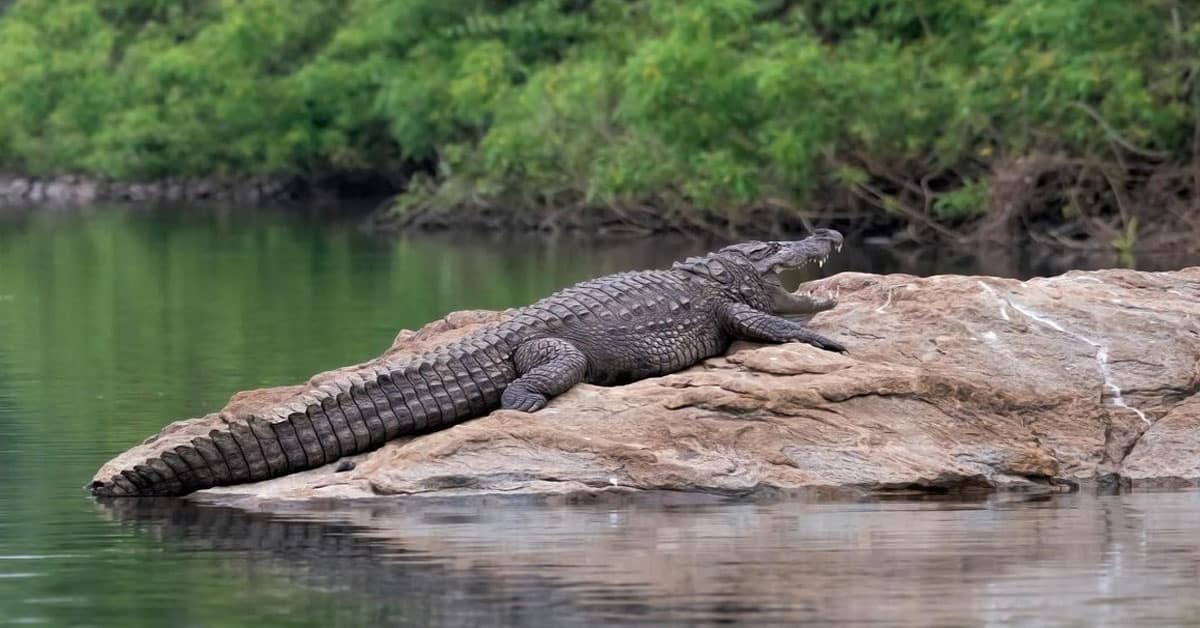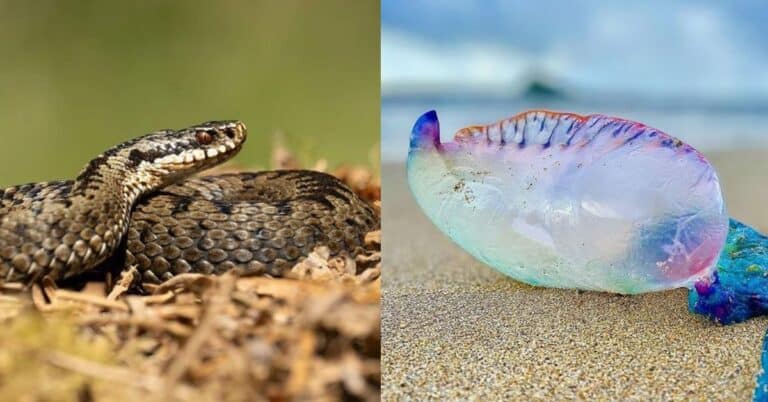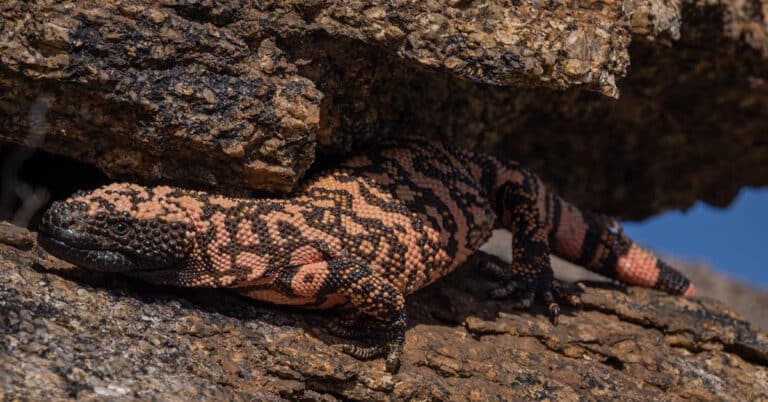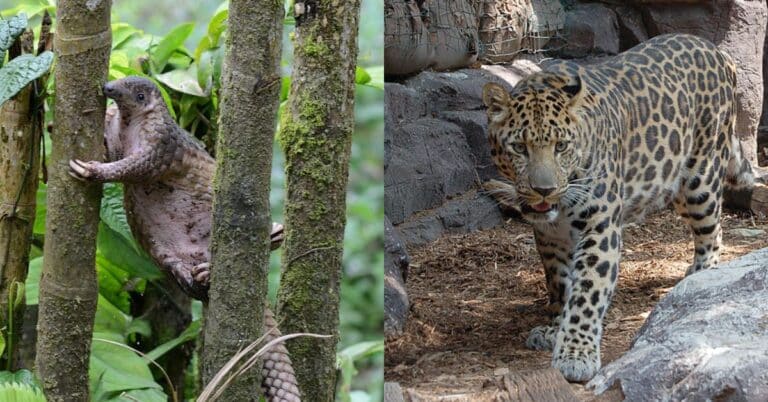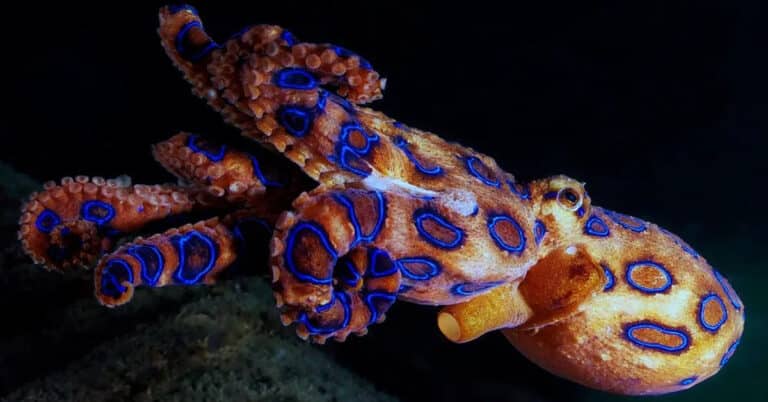15 Strongest Animal Bite Forces in the World
There are a lot of animals out there that you wouldn’t want to find yourself in the jaws of, and that’s what this list is all about. Today, we’ll be going over the top 15 animals in the world with the strongest animal bite force measured by PSI.
PSI measures the amount of pounds of pressure per square inch.
From mammals to reptiles, to animals that no longer exist, this list has all sorts of fascinatingly dangerous creatures in it.
Continue reading to see the top 15 strongest animal bite forces in the animal kingdom:
15. Siberian Tiger (1,000 PSI)
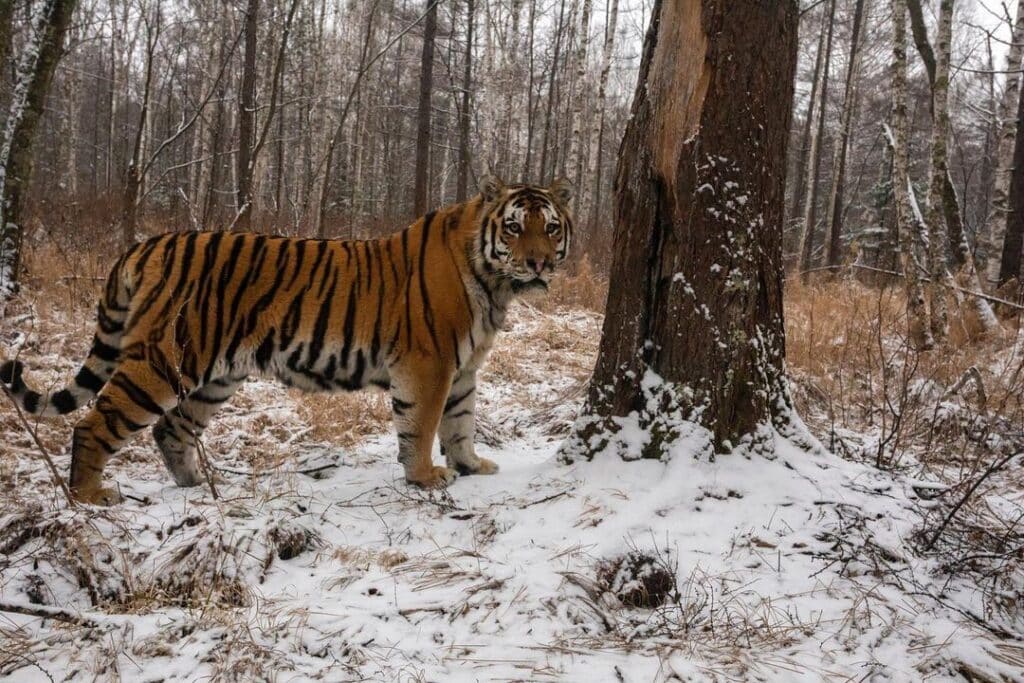
- 30 teeth (2.5-to-3 inches long)
- Average lifespan of 16-25 years
- Estimated Wild Population: 500
The 15th-strongest animal bite force in the world comes from the Siberian tiger, a large cat that grows upwards of 10 feet in length, averaging around 660 pounds for mature specimens with males being larger than females.
These beautifully striped mammals range from the northern and eastern stretches of Russia, which of course includes Siberia.
Siberian tigers are the largest cats on the planet that still exist, and it is assumed that less than 500 of them live in the wild today. Approximately 400 of them inhabit Russia’s birch forests, with the rest of them ranging through eastern China and North Korea.
Their diet consists of elk, boars, bear, and deer native to their area.
14. Alligator Snapping Turtle (1,000 PSI)
- Average lifespan of 35-to-70 years, sometimes up to 100 years
- Estimated Wild Population: 360,000
The largest freshwater turtle in North America, the alligator snapping turtle can reach upwards of 29 inches in length, weighing up to 250 pounds. Males tend to grow larger than females, and it is estimated that there are 360,000 of them left in the wild, distributed through 12 states.
Alligator snapping turtles can be found in lakes, rivers, and swamps of the eastern and mid-western ranges of the United States, anywhere from Florida to Texas, and as far north as Illinois and New York.
These animals are primarily carnivorous, feeding on fish and other aquatic animals, as well as small mammals. At times however they will also consume vegetation.
With the strongest animal bite force of any turtle on earth, their viciously powerful beaks chomp right through bone and swallow whatever is bitten off; it could literally take your hand clean off with no issue.
13. Bengal Tiger (1,050 PSI)
- 30 teeth (3-to-3.5 inches long, largest teeth of any living cat)
- Average lifespan of 10-to-25 years
- Estimated Wild Population: 2,000-to-5,500
Slightly smaller than the Siberian tiger, Bengal tigers reach up to 9.5 feet for males, and 8.7 feet for females. Males generally weigh around 480 lbs at full maturity, though they’ve been recorded as high as 570 lbs, while females rarely exceed 350 lbs.
Bengal tigers inhabit areas such as India, southern Nepal, Bangladesh, Bhutan, and southwestern China.
Like the Siberian tiger, the Bengal tiger feeds on the big mammals native to its area, such as deer, boar, cattle, and goats.
Both Siberian tigers and Bengal tigers live on the same land mass, though distributed through different countries; both are from the genus Panthera, and it is believed that they used to be the same exact cat until they went their separate evolutionary ways between 80,000-and-100,000 years ago.
Both have 30 teeth, 16 on the top, and 14 on the bottom rows of their jaw. And, the Siberian tiger of course has longer fur to aid them in dealing with the most hostile (cold) environment on earth., while Bengals have a much thinner coat.
12. Spotted Hyena (1,100 PSI)
- 32-34 teeth (.2-to-.3 inches long)
- Average lifespan of 12-to-25 years, one individual in captivity made it to 41 years
- Estimated Wild Population: 27,000-to-47,000
Spotted Hyena’s are one of the most dangerous animals on planet earth. This is of course thanks to their bite force, but also because they hunt in packs ranging from 6-to-100 members.
These vicious animals have developed short, powerful canines in the front of their mouths to help them rip apart whatever animal they’re eating.
Spotted hyenas can be found throughout Africa, as well as Arabia and India, and they can grow over five feet long, weighing up to 140 pounds, females being slightly larger than males.
Hyena’s will often times scavenge for their food, feeding on what other predators left behind. However, don’t let that fool you, they are incredibly skilled hunters themselves that regularly take down antelope, wildebeest, warthogs, goats, cattle, sheep, amongst others every day.
11. Grizzly Bear (1,160 PSI)
- 42 teeth (2.5-to-3 inches long)
- Average lifespan of 20-25 years, one individual in captivity made it to 47 years
- Estimated Wild Population: 55,000-to-60,000
Grizzly bears grow up to 6.5 feet in length, and they can weigh up to 600 lbs, with males often times weighing nearly twice that of females, which rarely exceed 440 lbs.
They inhabit the western United States in areas such as Alaska, Wyoming, Montana, Idaho, Washington, and Colorado, and they’re also found in parts of Canada.
These massive bears are omnivores, feeding on a variety of vegetation including berries, grass, herbs and roots, and they’ll also eat insects, deer, moose, squirrels, mice, bison, and of course, salmon.
10. Polar Bear (1,200 PSI)
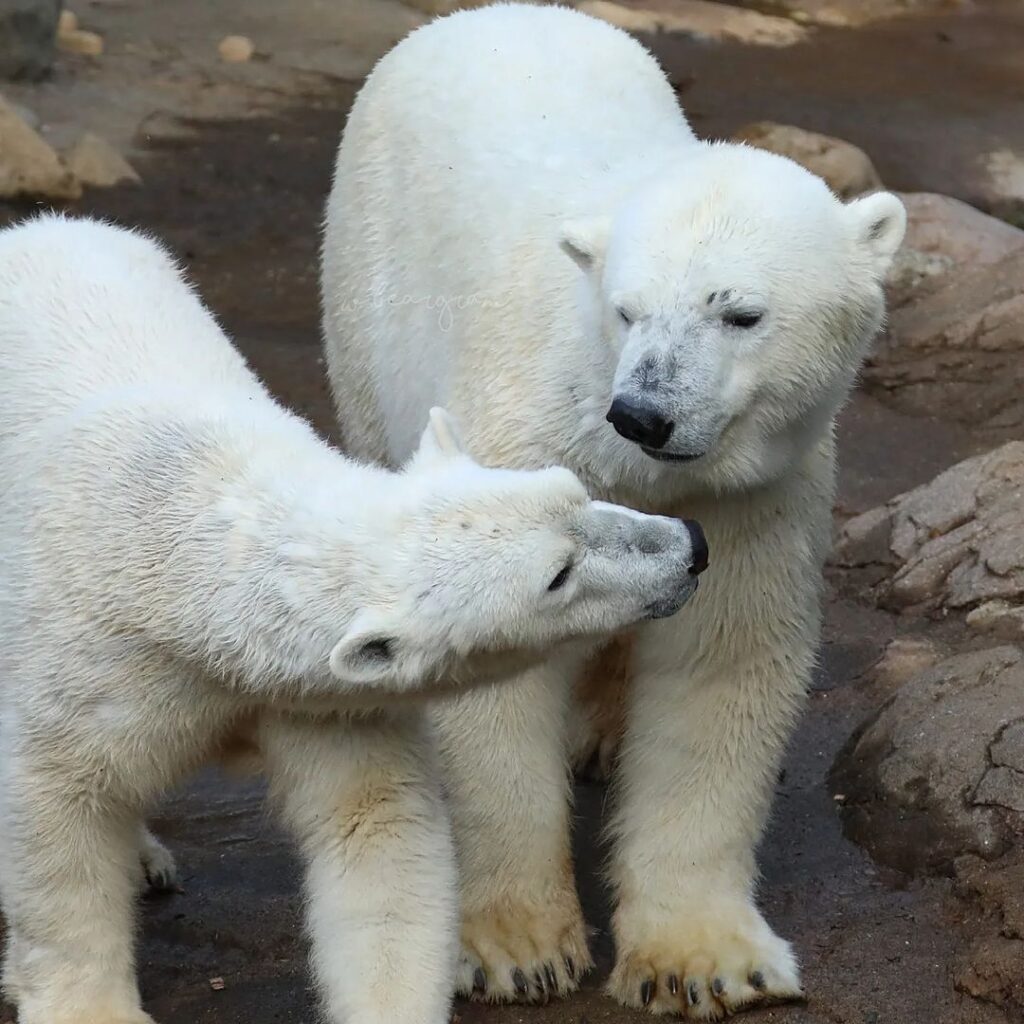
- 42 teeth (2 inches long)
- Average lifespan of 15-30 years
- Estimated Wild Population: 22,000-to-31,000
Holding the tenth strongest animal bite force in the animal kingdom, we introduce to you polar bears.
Believe it or not, polar bears evolved from brown bears between 343,000-and-479,000 years ago.
Polar bears are by far the largest bears in the world, reaching nearly 10 feet in length, and weighing up to 990 lbs. Again, males are larger than females in this species by almost twice the size. Females generally weigh around 550 lbs for the biggest specimens, and are one-to-two feet shorter on average.
These miraculous creatures range north of the Arctic Circle to the North Pole, living in Alaska, Canada, Russia, Greenland, as well as some Norway-owned islands such as Svalbard.
Polar bears feed almost entirely on seals, such as harbor seals, hooded seals, bearded seals, harp seals, and ringed seals. Alternatively, polar bears will also occasionally eat muskox (cattle), caribou, rodents, waterfowl (bird), shellfish, and fish.
There are an estimated 22,000-to-31,000 polar bears in the world today. However, due to manmade climate change, it is expected that two thirds of the population will die off by then.
When regarding the strongest animal bite force of any bear alive, the polar bears sit at no. 1.
9. Silverback Gorilla (1,300 PSI)
- 32 teeth (2 inches long)
- Average lifespan of 35-40 years, sometimes up to 50 years
- Estimated Wild Population: 100,000 western lowland, 5,000 eastern lowland, 1,000 mountain gorillas
Silverback gorilla’s are surprisingly not as massive as one might think, generally ranging from 4’11” to 5’11” inches in height for males, the tallest ever recorded standing exactly 6′ tall. They weigh between 300 and 430 lbs, though the weight of the 6′ specimen recorded was 589 lbs.
This number can grow in captivity, as they become obese quite easily.
Females on the other hand stand about 4’5” and can weigh upwards of 200 lbs.
These primates live in equatorial (near the range of the equator) Africa, and they have a lowland, and highland subspecies. They generally live in groups of 5-to-10, but have been found in groups as low as two, to as high as 50.
Gorilla’s mainly keep a vegetarian diet, feeding on stems, bamboo, and a variety of fruit and vegetables. Lowland gorilla’s however will also eat ants, termites, and larvae.
Gorilla’s have the strongest animal bite force of any primate alive today.
8. Bull Shark (1,350 PSI)
- 50 rows of teeth, totaling 350+ (1 inch long)
- Average lifespan of 16-to-32 years
- Estimated Wild Population: 100,000, though difficult to tell considering they live in a multitude of giant bodies of water
Bull sharks, to us humans, are by far the most dangerous sharks on the planet, and for a few reasons. For one, most sharks will bite humans just once in a case of mistaken identity.
We’re quite bony comparative to a sharks usual diet, lacking the muscle and fat of their favored food sources, thus making an inadequate meal for them. However, bull sharks don’t seem to mind our bony bodies, and you can count on them to continue attacking you after the initial strike.
What’s more, they can live in not only saltwater, but fresh water as well. Often times, mothers will birth their young in fresh water, giving them a low salinity content from the beginning of their life.
And, they hunt in packs, unlike most other predatory sharks. These sharks are truly fascinating, but dangerous.
Bull sharks live worldwide in tropical and subtropical waters, ranging the coasts of the United States, South America, Africa, Australia and its surrounding land masses, as well as the coast of the Indian Ocean.
As far as fresh water goes, they’ve been found in the Mississippi river (even as far up as Illinois), the Potomac river, and 2000 miles up the Amazon river.
These incredible specimens grow between 7-and-11.5 feet in length, and they can weigh between 200-and-500 lbs, with females growing larger than males.
As mentioned above, bull sharks are not whatsoever picky eaters, and they mainly feed on fish, a wide variety of marine mammals, other sharks (including their own), birds, and turtles.
7. Jaguar (1,500 PSI)
- 30 teeth (3-to-3.5 inches long)
- Average lifespan of 12-to-20 years, one individual made it to 28 years in captivity
- Estimated Wild Population: 173,000
The biggest cat in the Americas, and the third biggest cat in the world, the jaguar can grow up to just over six feet in length. This is not including their tail, which can reach roughly 2.6 feet, and they weigh between 120-and-210 lbs, males being larger than females.
Jaguar’s have quite a wide range in habitat, reaching from southern Arizona through the tropical forests of Central and South America, and they go as far as northern Argentina.
These opportunistic hunters feed mostly on small mammals, as well as deer, armadillos, fish, birds, monkeys, and reptiles such as tortoises and iguanas.
They also have been known to take down caimans, which is quite remarkable. With the strongest animal bite force of any living cat, that comes as no surprise.
6. Hippopotamus (1,800 PSI)
- 36 teeth (incisors, or front teeth, can grow up to 15 inches long)
- Average lifespan of 40-to-50 years, one individual made it to 61 years in captivity
- Estimated Wild Population: 115,000-to-148,000
We all know hippos are massive, but their size at full maturity is staggering.
These water-dwelling mammals can grow up to 17 feet in length, and they can weigh as much as 4,000 lbs, females being slightly smaller than males, tipping the scales between 2,900-and-3,300 lbs.
Hippopotamus’ live in lakes and rivers throughout central and southern Africa in countries such as the Congo, Uganda, Tanzania, Kenya, Ethiopia, Somalia, Sudan, and Gambia.
The hippos diet consists almost entirely of grass, though they will on occasion feed on aquatic plants. It’s quite astounding how much they eat too, as they’re known to consume upwards of 88 lbs of greens a day.
5. Great White Shark (4,000 PSI)

- 5 rows of teeth, totaling 300+ (how big?)
- Average lifespan of 40-to-70 years, sometimes up to 100 years
- Estimated Wild Population: 3,500, could go extinct within the century if humans do not stop harvesting them
The worlds most famous shark lives all around the world, on every major coast, as well as in the open ocean throughout every major body of water.
Male great white sharks tend to grow between 11-and-13 feet in length, with females averaging 15-to-16 feet. The biggest great white ever recorded however was 19.5 feet long.
Though they generally weigh between 1,500-and-2,400 lbs, it is believed they can grow upwards of nearly 5,000 lbs for the biggest specimens in the world.
These intimidating creatures feed on fish as juveniles, switching to sea mammals such as seals, sea lions, and whales as they mature.
Unfortunately, there hasn’t been enough research to truly study the bite force of a great white, so their number of 4,000 PSI is an educated guesstimate. They surely have one of the strongest animal bite forces on the planet, but it’s hard to be certain what the exact number is.
That is also the case for our no. 4 spot on the list of strongest animal bite forces.
4. Orca (19,000 PSI)
- 40-56 teeth (roughly 3 inches long)
- Average lifespan of 30-to-50 years, sometimes up to 80 years
- Estimated Wild Population: 50,000
Killer whales have perhaps the strongest animal bite force in the animal kingdom today. But, as mentioned above, there isn’t enough research to prove it yet, so we’ll put them behind the three animals’ bite strength we’re certain of.
However, it is estimated that Orcas have nearly 20,000 lbs of pressure per square inch in their bites, which is just remarkable.
They can reach anywhere from 16-to-23 feet in length for females and 20-to-26 feet for males. The largest male ever recorded weighed 22,000 lbs and reached 32 feet in length, while the largest female ever recorded was a whopping 28 feet.
However, females generally weigh around 8,000 lbs, with males rarely exceeding 12,000 lbs.
Orcas are one of the widest-distributed animals in the world, living across every (open) ocean, and on every coast. They are most abundant in colder waters around Antarctica, Alaska, and Norway, though they’re also found in tropical and subtropical waters.
Orcas feed on herring, stingrays, sharks, whales, seals, and a number of schooling fish.
3. American Alligator (2,125 PSI)
- 80 teeth (3.5-to-3.75 inches in large specimens)
- Average lifespan of 30-to-50 years, sometimes up to 75 years
- Estimated Wild Population: 5,000,000
Alligators are fascinating animals. As a member of the crocodilian family, they’ll often grow past 10 feet in length; males growing up to 15 feet on average, and females growing up to about 9 feet in length.
Males generally weigh around 500-to-1,000 lbs at full maturity. However, the biggest alligator ever recorded was measured at 19.2 feet and weighed 2,200 lbs.
Alligators range the south to the southern mid-western parts of the United States, in states such as Florida, Texas, Louisiana, Georgia, Alabama, and smaller numbers can be found in both North and South Carolina.
Of the 28 species of crocodilian, 13 specimens ingest fruit and seeds as part of their diet, American alligators being one of them. In contrary, they mostly feed on fish, invertebrates, frogs, birds, a variety of mammals, and sometimes their own kind.
2. Nile Crocodile (3,000 PSI)
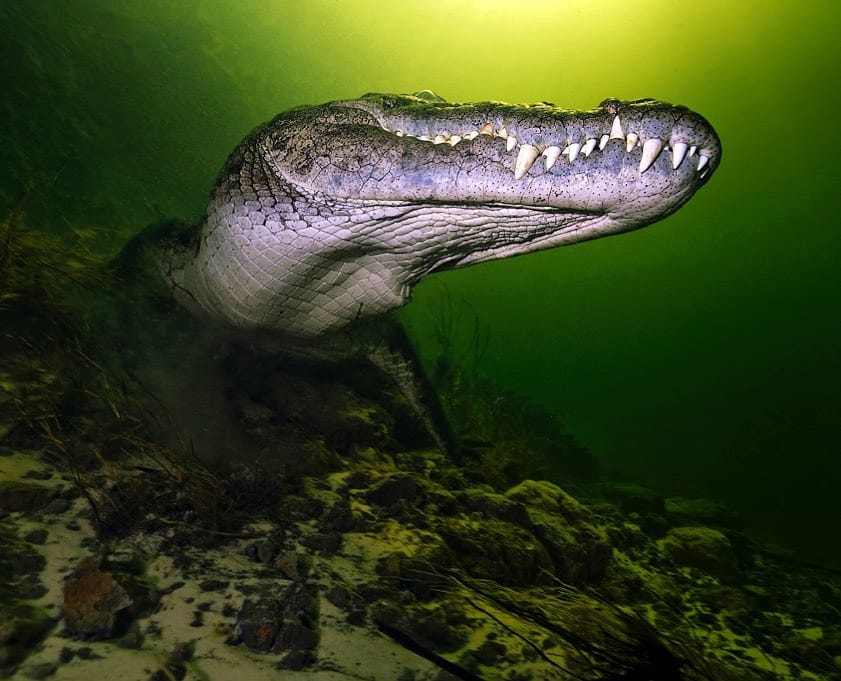
- 64-68 teeth (4 inches in large specimens)
- Average lifespan of 50-to-80 years, sometimes up to 100 years
- Estimated Wild Population: 50,000-to-70,000
Like alligators, male Nile crocodiles are larger than females, averaging 14 feet and weighing upwards of 1,700 lbs, while females usually do not exceed 12 feet and weigh an average of 550 lbs once mature.
The largest Nile crocodile ever recorded was found in Tanzania, it measured 21.2 feet, and it weighed 2,400 lbs.
Nile crocodiles have pretty much the same range as our no. 6 entry on this list, hippopotamus’, throughout the rivers, marshes, and mangrove swamps of central and southern Africa. They can however also be found in Madagascar.
These wickedly powerful animals feed on fish, but will also ambush zebras, smaller hippos, porcupines, birds, and other crocodiles. They’ll also scavenge for an easy meal. And, they’re one of the (seven) species that will actively hunt humans.
1. Saltwater Crocodile (3,700 PSI)
- 66 teeth (exceeding 4 inches in large specimens)
- Average lifespan of 70-to-80 years, sometimes up to 100 years
- Estimated Wild Population: 150,000-to-200,000
Saltwater crocodiles are proven to be the largest living reptile in the world today, which comes as no surprise when they come in at no. 1 for the strongest animal bite force on the planet.
Like the previous crocodilians on this list, males are larger than females. They’ll generally grow up to around 17 feet, though they’ve been known to grow past 20 feet, and they can weigh as much as 2,900 lbs.
These impressive specimens are most prevalent on the northern coast of Australia, but also range the coasts of India, Bangladesh, Thailand, Malaysia, Papua New Guinea, Somalian Islands, Indonesia, and the Philippines, to name a few.
Saltwater crocodiles, like all crocodilians, are opportunistic hunters, feeding on anything they can overpower such as fish of all kinds, turtles, monitor lizards, snakes, birds, cattle, buffalo, and boars.
Juveniles however will feed on insects, crustaceans, small reptiles, frogs, and small fish. And, saltwater crocs, like Nile crocodiles, are known to actively hunt humans.
Ancient Honorable Mentions
1. T-Rex (12,800 PSI)
- 60 teeth (between 6-and-12 inches long)
- Estimated average lifespan of 28-to-30 years
Fossils of these ancient, devastatingly powerful and massive creatures are found in North America, most of them being discovered in South Dakota and Montana. But, it is believed that they could have stretched as far north as Alaska, and as far south as Mexico.
T-Rex’s grew upwards of 40 feet in length and 12 feet in height. That means, you take two average sized male humans, stack them on top of one another, and the T-Rex, at full size, is still taller than them combined.
It is estimated that they could have weighed in between 11,000-and-15,500 lbs, and as carnivores, that’d make for a very scary adversary to meet in the wild.
2. Megalodon (40,000 PSI)
- 276 teeth (often times exceeding 7 inches, largest ever found just under 7.5 inches)
- Estimated average lifespan of 88-to-100 years
The largest shark ever recorded, the megalodon is estimated to have grown between 50-and-60 feet at full maturity, but other scientists believe it could have exceeded 80 feet.
It’s very difficult to tell, considering the only thing we have to guesstimate it on is their teeth. However, we’re able to compare those teeth to their closest living relatives, the great white shark.
And, because of this, those are the lengths most scientists agree on.
Megalodon’s also could have weighed as much as 50-70 tons, or 100,000-to-140,000 lbs, which is just astonishing.
Though some scientists cannot agree on the exact size of megalodon, one thing is agreed upon universally, and that’s that the megalodon has the strongest animal bite force of all-time.
3. Deinosuchus (23,100 PSI)
- Up to 30 teeth (6-to-8 inches long)
- Estimated average lifespan of 50-to-80 years
Though not to biggest crocodilian to ever live, that title goes to the Sarcosuchus, it is estimated that the Deinosuchus had the strongest animal bite force of any crocodilian in history.
Measuring 35 feet in length, the Deinosuchus is actually just the fifth-biggest crocodilian ever recorded. But, it had an estimated bite force of 23,100 lbs per square inch, and weighed around 11,000 lbs, whereas the Sarcosuchus measured 41 feet, likely weighed around 17,600 lbs, and had a bite force of roughly 18,000 lbs of pressure per square inch.
If you enjoyed this piece, perhaps you’ll enjoy this one we did on the top 10 most venomous snakes in the world.
And, if you enjoyed this piece on the top 15 strongest animal bites in the animal kingdom, feel free to share it on social media or leave a comment below!

I started writing in the fourth quarter of 2018. I wrote solely about MMA and boxing up until October of 2022, where I began writing about animals; primarily dangerous, venomous species. They’ve always fascinated me. Considering, my goal is to make a living by teaching people about these wonderful creatures. You can check out my Facebook page, where every article I’ve ever written currently sits, or you can check out my Twitter page, where I’ve shared all of my animal pieces to date.

